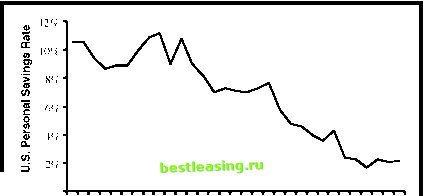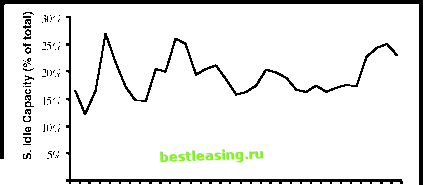

 |
 |

|
Промышленный лизинг
Методички
Because of financial market declines, the total wealth of U.S. families in 2004 was almost identical to that in 2000.2 Even as wealth has not increased, U.S. consumers have continued to spend. Unfortunately, income growth has also slowed considerably. The average annual growth rate of disposable personal income dropped from 4.0% in the five years ending in 2000 to 2.7% so far in the twenty-first century.3 So if U.S. consumers are not getting richer, and have less income to spend, is there hope of continued spending? Yes, but it will have to come by decreasing the savings rate. Figure 4.3 shows the savings behavior of U.S. consumers. From a historical level of around 10%, the U.S. personal savings rate has declined toward zero. While it is possible for the savings rate to decline even further, I read the chart to indicate a possible rebound in savings. A return to a higher U.S. savings rate is a positive development for the long run, but it means that the U.S. consumer is unlikely to be the engine of economic growth over the next few years. This idea that increased savings hurts the economy is known as the  * part of year FIGURE 4.3 Americans Do Not Save Very Much Source: U.S. Commerce Department paradox of thrift. Saving money is prudent and good for the individual, but the more people save, the less they buy. To summarize the state of the U.S. consumer, both wealth and income growth have slowed. For U.S. consumers to continue to support the economy, the savings rate would have to decline even further. If consumers return to their more traditional, higher rates of savings, their rediscovered frugality will place a serious drag on the economy. Conclusion: The U.S. consumer is unlikely to be a major source of economic growth. U.S. Businesses What about investment by U.S. businesses? One of the important factors driving business investment is the amount of idle production capacity. Simply put, companies with idle facilities are not likely to be aggressive purchasers of new equipment. Figure 4.4 shows the percentage of idle capacity for U.S. businesses. U.S. businesses have about one-quarter of their capacity sitting idle, and this level has increased rapidly since the bursting of the bubble. Companies have enough spare capacity to accommodate years of economic growth without any additional investment. The two recessions of the early 1980s and 1990s also had high levels of idle capacity. The personal savings rate diagram (Figure 4.3), shows that those recessions ended when U.S. consumers sharply decreased their savings rate throughout the 1980s and 1990s. In previous recessions, high levels of idle business capacity were put to use when consumers increased spending. Thus, a key to U.S. business spending lies with the U.S. consumer. If consumers increase their spending, business investment will follow. If the U.S. consumer cannot be an engine of growth, then businesses are unlikely to increase their investment spending. Conclusion: U.S. businesses may follow, but they are unlikely to lead economy recovery.  * part of year FIGURE 4.4 Lots of Excess Capacity in America Source: Federal Reserve Foreigners In the midst of the 1990s stock market bubble, one of the common justifications for ridiculous stock prices was the entry of China into the world economic system. Ciscos high stock price, it was widely said, made sense because Cisco would sell a lot of product to China. More broadly, the hope was that U.S. companies could export products to many foreign markets and thus not depend on the U.S. consumer. While this export-based argument was wrong with regard to stock prices (Cisco shares have lost 75% of their value), a significant and growing proportion of U.S. output is indeed sold to foreign consumers. With U.S. consumers possibly looking to save, and U.S. factories sitting idle, perhaps the foreign consumer will provide growth. Unfortunately, important foreign economies are not in great shape. Japan and Germany-the worlds second and third largest economies- continue to struggle to recover from economic slumps. The German economy is barely growing at all, and the German unemployment rate is near 10%.4 The Japanese economy is not in much better shape. Since the late 1980s, 1 2 3 4 5 6 7 8 9 10 11 12 13 14 15 16 17 18 19 20 21 22 23 24 25 [ 26 ] 27 28 29 30 31 32 33 34 35 36 37 38 39 40 41 42 43 44 45 46 47 48 49 50 51 52 53 54 55 56 57 58 59 60 61 62 63 64 65 66 67 68 69 70 71 72 73 74 75 76 77 78 79 80 81 82 83 84 85 86 87 88 89 90 91 92 93 94 95 96 97 98 99 100 101 102 103 104 105 |